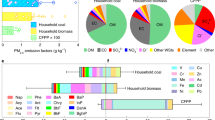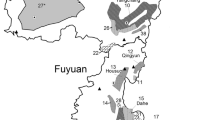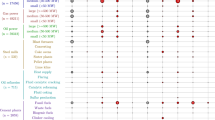Abstract
Mixing dried human sewage sludge with pulverized coal is being evaluated as a way to reduce carbon dioxide emissions from traditionally coal-fired power plants, as well as to overcome sewage-disposal problems. Here we investigate the effects of inhaling particles emitted from the combustion of this mixture and find that these cause significantly more lung damage in mice than do particles from coal alone, probably because of their zinc content. Our findings indicate that the use of dried municipal sewage sludge as a 'green' (CO2-neutral) replacement fuel should be considered with caution.
Similar content being viewed by others
Main
Airborne particulate matter is associated with acute respiratory distress in humans1. Suggested causes2 of the lung damage caused by these particles include their composition — for example, they may contain soluble transition metals such as copper, iron, vanadium, nickel or zinc — their acidity, and their ultrafine size (some particles are less than 0.1 μm in diameter). These properties are all features of airborne particulate matter resulting from the co-combustion of pulverized coal and biomass, including dried municipal sewage sludge (MSS).
Combustion of pulverized coal (from the University of Stuttgart) and of MSS/coal mixtures was performed in a semi- industrial-scale, 500-kW downfired pulverized-fuel combustor3. MSS had been processed (Swiss 'Combi' process) to produce 2–4-mm pellets, which were then pulverized and mixed (20% thermal, 50% mass load) with coal. Sampled particulate matter was resuspended and diluted4 to a sufficiently low concentration to allow the effects caused by different particle properties to be assessed on exposed mice. Mice were exposed for only 1 hour each day for 24 consecutive days to a low dose of 1,000 μg m−3 and to a high dose of 3,000 μg m−3 (the atmospheric dose of particulate matter less than 10 μm in diameter currently allowed by the United States Environmental Protection Agency is 150 μg m−3 averaged over 24 hours).
Figure 1 indicates that co-combustion of MSS/coal ash produces airborne particulate matter that has a significant effect on lung permeability in mice, increasing with dosage, which is greater than the effect of either air on its own or a high dose of particles produced by burning only coal ash, which appears to be relatively benign. Cell counts in broncho-alveolar lavage fluid in our mice decreased after exposure to particulate matter from MSS/coal, compared to ambient air and coal ash alone, which again appears relatively benign (Fig. 1). (Details of measurement techniques and the use of anaesthetic and paralytic drugs to minimize discomfort and pain in the mice can be obtained from M.L.W.) We found no significant differences in other pulmonary functions (pulmonary compliance or resistance). Increased lung permeability enhances access by a toxin to the lung interstitium and pulmonary circulation, correlating with the extent of pathological lung injury.
Thirty-two specific, pathogen-free mice (strain C57BL/6) were randomly divided into four groups (weight, 25.0 ± 4.3 g; n = 8), housed at 8 per cage under a 12-h light/12-h dark cycle at the Arizona Health Science Center animal facility (approved by the American Association for the Accreditation of Laboratory Animal Care, to ensure proper treatment of animals), and fed a standard chow diet and tap water. Results were analysed 24–30 h after the final exposure to airborne particulate matter (see text). Cells were counted from the first 3 of 6 lavages (1 ml sterile isotonic saline) of the lungs. In the top bar graph, the asterisk symbol indicates statistical significance compared with exposure to particles from the coal/sewage ash of P < 0.0001; in the bottom graph, the asterisk and hash indicate statistical significance compared with exposure to coal/sewage ash particles of P < 0.0005 and P < 0.0001, respectively. Error bars indicate ±s.d. Bars: 1, controls; 2, values corresponding to coal-ash exposure dose of ∼3,000 μg m−3; 3 and 4, values for coal/sewage-ash exposures of ∼1,000 μg m−3 and ∼3,000 μg m−3, respectively.
We measured the distribution in particle sizes to which the mice were exposed by using a Berner low-pressure impactor, and recorded differences in mass and concentration of certain elements. Mass and size distributions for particles produced by coal/MSS ash mixtures and by coal ash on its own are quite similar, although the coal ash generates a slightly greater fraction of nanometre-sized particles. We conclude that the increased toxicity of the MSS/coal is not due to a difference in the size of the particles it produces on combustion.
Instead, the toxic effects seem to be associated with the presence of zinc in the particles. Combustion of MSS together with coal increases the concentration of zinc in the resulting airborne particulate matter in the respirable-size particles (diameters between 0.3 and 2.5 μm) from 2 to 14 wt% and in ultrafine particles (diameter smaller than 0.1 μm) from 4 to 11 wt%. MSS also produces 10 wt% cobalt in the utrafines. Selenium, arsenic, lead and vanadium were present in similar amounts in particles from MSS/coal and from coal, whereas more iron was found in particles from coal burned alone. We therefore believe that zinc is the culprit metal that causes an increase in a measurable precursor for lung damage, a conclusion that is supported by other measurements5 of lung inflammation after intratracheal injection.
The replacement of coal by MSS in power stations is being considered as one option to help meet the requirements of the Kyoto Protocol and to replace landfill disposal of MSS. Our results, indicating that the toxicity to mice of inhaling particles from coal/MSS co-combustion is greater than from coal alone, suggest that the environmental advantages may be tempered by the risk to respiratory health.
References
Dockery, D. W. et al. N. Engl. J. Med. 329, 1753–1759 (1993).
Lighty, J. S., Veranth, J. M. & Sarofim, A. F. J. Air Waste Manag. Assoc. 50, 1565–1618 (2000).
Cenni, R., Frandsen, F., Gerhardt, T., Spliethoff, H. & Hein, K. R. G. Waste Manag. 18, 433–444 (1998).
Fernandez, A., Wendt, J. O. L., Cenni, R., Young, R. S. & Witten, M. L. J. Air Waste Manag. Assoc. (submitted).
Adamson, I. Y. R., Prieditis, H., Hedgecock, C. & Vincent, R. Toxicol. Appl. Pharmacol. 166, 111–119 (2000).
Author information
Authors and Affiliations
Corresponding author
Rights and permissions
About this article
Cite this article
Fernandez, A., Davis, S., Wendt, J. et al. Particulate emission from biomass combustion. Nature 409, 998 (2001). https://doi.org/10.1038/35059169
Issue Date:
DOI: https://doi.org/10.1038/35059169
This article is cited by
-
Particulate inorganic salts and trace element emissions of a domestic boiler fed with five commercial brands of wood pellets
Environmental Science and Pollution Research (2020)
-
Comparison of saccharification and fermentation of steam exploded rice straw and rice husk
Biotechnology for Biofuels (2016)
Comments
By submitting a comment you agree to abide by our Terms and Community Guidelines. If you find something abusive or that does not comply with our terms or guidelines please flag it as inappropriate.




